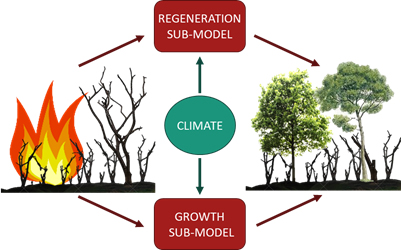New article: From stand to landscape: modelling post-fire regeneration and species growth

How does a forest change after a fire?
In this new work published in the Ecological Modeling journal, the authors propound this question for the Mediterranean forest. They propose specific responses via simulating species regeneration and species growth in burned areas.
Landscape models are comprehensive tools that allow for an understanding of landscape dynamics and a means of deriving future projections in the context of global change. Vegetation and ecological processes such as growth, death or regeneration are essential components of forest landscape dynamics, but their inclusion in landscape-level modelling frameworks is not straightforward as there is a trade-off between model feasibility, desirable complexity and the inclusion of relevant ecological processes. If models are to project future landscape dynamics, climatic influence on vegetation processes needs to be integrated; however, this usually leads to a major increment in model complexity. Here, a post-fire regeneration model (in terms of tree species) and a growth model (in terms of basal areas) is presented for Mediterranean forests including climate influences on such processes. The model captures vegetation dynamics at the stand level and accounts for post-fire regeneration and vegetation growth at the landscape level, with inclusion of the dynamically influencing effect of climate. The model was calibrated with 7709 inventory data plots and validated with 233 burned plots in the Mediterranean region of Catalonia (NE Spain). Results show that our model is able to accurately predict tree species post-fire regeneration and biomass growth. They also show that integration of climatic information represents a significant improvement on the predictive accuracy of the model. Overall, this study presents a generic approach to extend local vegetation dynamics information to the landscape level; furthermore, allowing the projection of vegetation dynamics under changing climatic conditions.
https://www.sciencedirect.com/science/article/pii/S0304380019301668?via%3Dihub




